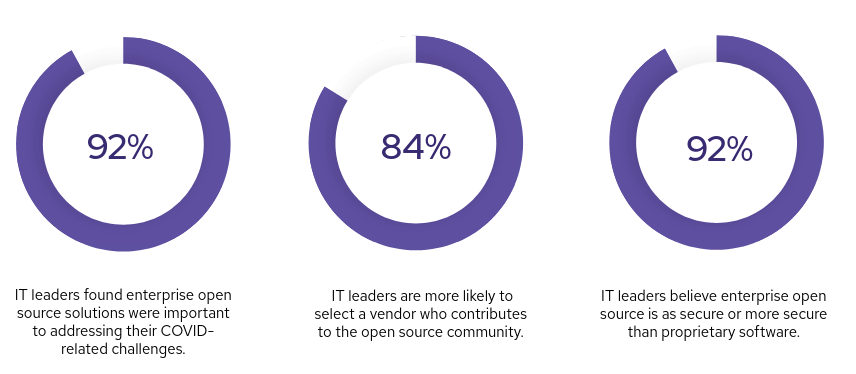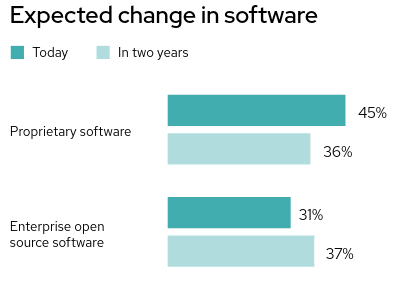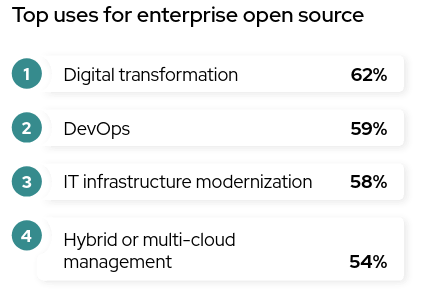04.12.2024
CompTIA A+ Certification: Your Comprehensive Guide

Posted by Marbenz Antonio on November 14, 2022

There is a wide range of industries involved in retail all across the world. Franchise businesses, local stores selling necessities like food and supplies, and businesses that produce and market goods with a strong global brand are all examples of this. However, for the vast majority of retail enterprises, profit margins are low and getting even lower. Some segments of the industry are widely known for producing high profits from small volumes.
Many retailers rightly rely on open-source software to keep their IT systems running given the context of low profits, constrained budgets, and the complexity of IT systems required to keep their company going. The benefits are well known: open source software is simple to use, trustworthy, and usually seen as being affordable.
So why should businesses be concerned with enterprise open-source software? That must have a cost, right?
The fourth edition of Red Hat’s The State of Enterprise Open Source research shows how businesses in a variety of industries are using enterprise open source to carry out their IT tasks.
“What we found as we embarked on our fourth annual The State of Enterprise Open Source: A Red Hat Report is that not only is the open source development model showing no signs of slowing down, it has actually accelerated during the pandemic.” Paul Cormier, Chairman, Red Hat
The report, which analyzes the use of enterprise open-source software, is based on interviews with 1,296 IT leaders from 14 countries. The survey’s sponsors, Red Hat, were not disclosed to the respondents, who claimed to have control over purchasing decisions in their company (in app development, app infrastructure, cloud, storage, middleware, server OS, or virtualization). Additionally, respondents had to be knowledgeable about corporate open source and have at least 1% of Linux installed in their organizations.
The outcomes are obvious. Enterprise open-source software, according to IT leaders, offers a better security posture and is generally of higher quality than proprietary options. These two points are important factors in their decision-making process. When IT leaders research enterprise open-source software, the cost is still a factor, but it’s not the only one. This is supported by the fact that 95% of respondents indicated that enterprise open source is important to the successful enterprise infrastructure of their organization.
The State of Enterprise Open Source: Retail’s analysis of the key findings from the retail business offers some interesting insights into the retail industry, which included 90 IT leaders from the retail sector from 14 different countries.
It’s interesting to note that 92% of IT leaders believed that corporate open-source solutions were important in managing their COVID-related difficulties given that retail underwent a metamorphosis during the recent COVID pandemic on a global scale.
Any retail organization must now prioritize protecting customer data while bolstering IT system security. According to the research, 92% of IT leaders think enterprise open-source software is just as secure as proprietary software, if not more so.

The retail industry is always changing. Retailers are continuously looking for ways to better serve their customers as a result of declining profit margins, quickly rising costs and more complex supply networks.
Enterprise open-source solutions can usually differentiate a company from its competitors for a retail customer when pursuing business innovation with next-generation technology and ongoing development. According to the study, 78% of IT leaders expect using enterprise open-source software for emerging technologies will increase.
Enterprise open-source software is replacing proprietary software in the hands of IT leaders more often. These IT leaders anticipate using less proprietary software in two years—from 45% to 36%—while using more enterprise open source software—from 31% to 37%. Enterprise open-source software has significantly replaced proprietary software as a result.

According to these data, retail IT professionals are increasingly depending on enterprise open-source software to foster company innovation and manage IT costs.
When IT leaders are asked how their organizations use enterprise open-source software and solutions, infrastructure modernization usually ranks as the most important answer for the majority of the industries included in the survey. This indicates that industries continue to replace their proprietary software and equipment. But in the retail sector, digital transformation comes out on top with 62%, followed closely by DevOps and modernizing the IT infrastructure with 59% and 58%, respectively.

Given that digital transformation, DevOps, and infrastructure modernization are the top three uses for enterprise open-source software, it follows that IT leaders in the retail sector are primarily concerned with enhancing their infrastructure while working to provide better services and features to their customers.
What does this mean for retailers? How exactly are they utilizing corporate open source to enhance their operations? The best approach to respond to this issue is with an actual example.
Local IT operations are usually managed by some servers that are usually found in the back room of brick-and-mortar retail establishments. They are used for a wide range of things, including recording refrigeration maintenance data, store and coworker work rotas, and stock movements.
Many establishments will also have security cameras that capture video feeds to a permanent data store for security reasons. The local store servers wouldn’t be a part of this system.
What might result from some kind of mix of the following? An AI system running on the local IT servers may record the video feeds as well as analyze them for behavior like:
The latency and network bandwidth required to transport the video stream off-site for processing and then return an alert to trigger some action would be too great for real-time video analysis to be performed in the store.
Although there are proprietary solutions out there, their cost to implement in every store can be too high. This is the situation where enterprise open source can help. If you think about the elements needed to make the solution work, they could be:
Red Hat is just one of the suppliers that provide enterprise open-source software that might be used to provide each of these components.
Enterprise open-source software offers a continuous conduit to the advancement of the technologies implemented in conjunction with other businesses across the ecosystem in the open-source community, in addition to being more cost-effective. Global retailers usually use a variety of hardware and operating systems, which enterprise open-source solutions can better support. It offers an unrestricted choice among the best-advanced techniques from a single original provider. Collaboration on platforms that can offer this as a service to the industry at large is inspired by the use of enterprise open source.
Retailers must set themselves apart from the competition by providing higher-quality products and services for their clients, workers, and company. For them to be able to achieve this, they must have the freedom to continuously develop the in-store experience for their customers with affordable solutions. Making this a reality requires having access to cutting-edge technology that will define the platforms of the future. When compared to proprietary or open-source alternatives, enterprise open-source technologies offer solutions that are more robust and efficient.
Here at CourseMonster, we know how hard it may be to find the right time and funds for training. We provide effective training programs that enable you to select the training option that best meets the demands of your company.
For more information, please get in touch with one of our course advisers today or contact us at training@coursemonster.com
